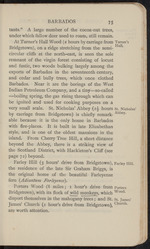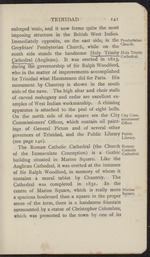| 1 |
 |
“...BARBADOS
75
tants.” A large number of the cocoa-nut trees,
under which fallow deer used to roam, still remain.
At Turner’s Hall Wood (2 hours by carriage from Turner’s
Bridgetown), on a ridge stretching from the semi- HaU-
circular cliffs at the north-east, is seen the sole
remnant of the virgin forest consisting of locust
and fustic, two woods bulking largely among the
exports of Barbados in the seventeenth century,
and cedar and bully trees, which once clothed
Barbados. Near it are the borings of the West
Indian Petroleum Company, and a tiny—so-called
—boiling spring, the gas rising through which can
be ignited and Used for cooking purposes on a
very small scale. St. Nicholas’ Abbey (2^ hours st. Nicholas'
by carriage from Bridgetown) is chiefly remark- Abbey'
able because it is the only house in Barbados
with fire-places. It is built in late Elizabethan
style, and is one of the oldest mansions in the
island. From Cherry Tree Hill, a short distance
beyond the Abbey, there is a striking...”
|
|
| 2 |
 |
“...bells.
On the north side of the square are the City City C°ra-
Commissioners’ Offices, which contain oil paint- office,
ings of General Picton and of several other
governors of Trinidad, and the Public Library Public
° . Library.
(see page 140).
The Roman Catholic Cathedral (the Church Roman^
of the Immaculate Conception) is a Gothic cathedral,
building situated in Marine Square. Like the
Anglican Cathedral, it was erected at the instance
of Sir Ralph Woodford, in memory of whom it
contains a mural tablet by Chantrey. The
Cathedral was completed in 1832. In the
centre of Marine Square, which is really more Marine
a spacious boulevard than a square in the proper quare'
sense of the term, there is a handsome fountain
surmounted by a statue of Christopher Columbus,
which was presented to the town by one of its...”
|
|
| 3 |
 |
“...General
Aspect.
270 GUIDE TO THE WEST INDIES
to 160 Frenchmen from St. Kitts. France en-
trusted the island to the Knights of Malta in
1651, and in 1733 it was purchased by King
Christian VI. of Denmark. In 1801 it was taken
by the English, but restored to the Danes after
a few months. Captured again by the English
under Sir Alexander Cochrane in 1807, it remained
British until 1814, when it was again handed to
the Danes.
In Christiansted, Mr. Pentheney's hotel is re-
commended.
There is regular semi-weekly communication
with St. Thomas by means of the government
packet schooner Viking, sailing from Bassin.
Steam communication between the islands has
been a long-recognised need, but one which it has
so far been found impossible to supply. The
Quebec line of steamers, however, proceed as a
rule from St. Thomas to West End or Frederick-
sted on their outward voyages. The roads of the
island are good, and well suited for cyclists.
ST. MARTIN
The joint-owned Island
St. Martin, which lies between...”
|
|
